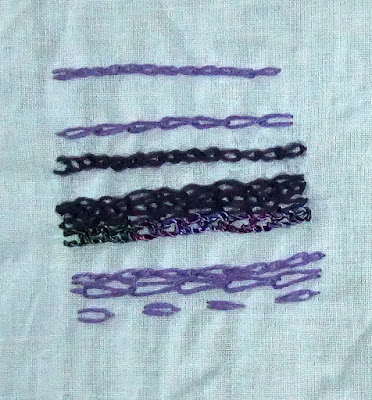Friday, 16 March 2012
Assignment 1: Project Two - Developing your marks - Stages 4/5 - Stitches which create texture
For this exercise I chose a range of yarns in the same colour family but with different thicknesses and texture. I also looked for differences in light reflectivity. My selection included thick cotton chenille thread, couched onto the fabric,
couched shiny viscose thread with stitched finer threads, crewel and floss,
embroidery flosses using variations of a simple straight stitch,
crewel wools and floss and dense, close stitching in satin stitch
and sparkly metallic threads with floss and crewel wool. In this sample I worked by weaving the metallic thread across a "frame" of floss to create a web-like effect.
Here I've used chain stitch and a combination of floss, viscose and crewel wool, using different stitch sizes and stitching closer together/further apart to create different densities on the fabric.
I can see potential uses for most of these samples; couching the viscose is useful to preserve the shine. It is thick, too, so it prevents damage to the fabric if it is laid on top. Nice curves can be achieved this way and good layering effects.
The simple straight stitch creates a lovely starburst effect just by varying the number and length of stitches that form the "legs" of the star.
Satin stitch is great for dense coverage and neat curves. The dullness of the wool is in contrast with the reflections in the floss.
The webbing was fun and made good use of the sparkle by allowing it to be concentrated in one area but allowing the background to show through. There was more sparkle and less waste by keeping the all of the thread on the front of the work. Again, this could be used for layering to add highlights.
The chain stitch would be useful for landscapes. It reminds me of paths, drystone walls, stones and walkways.






